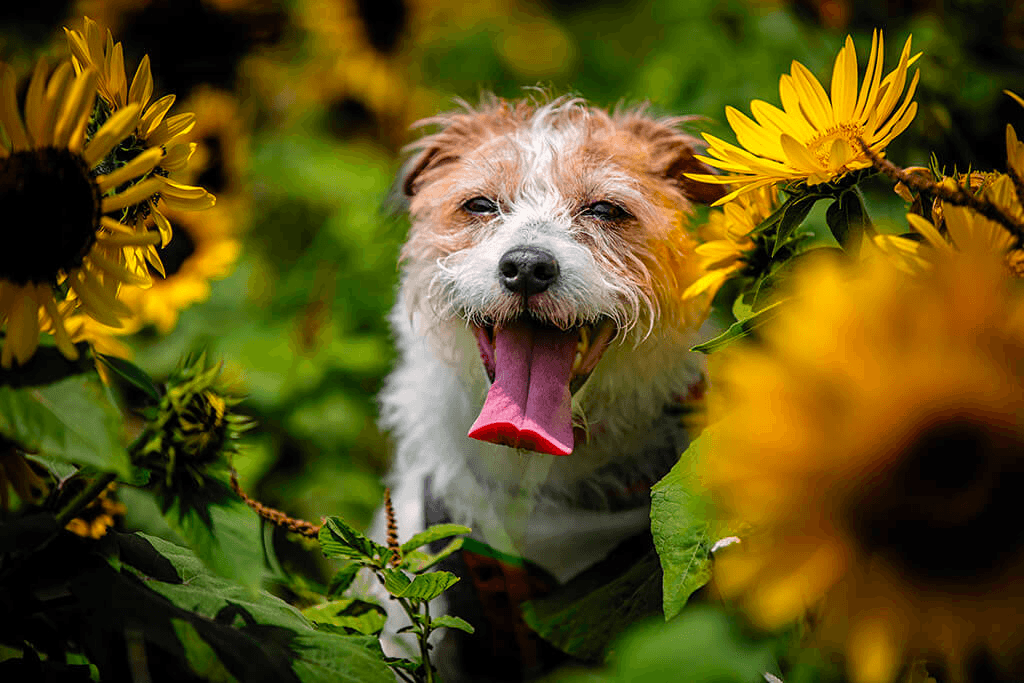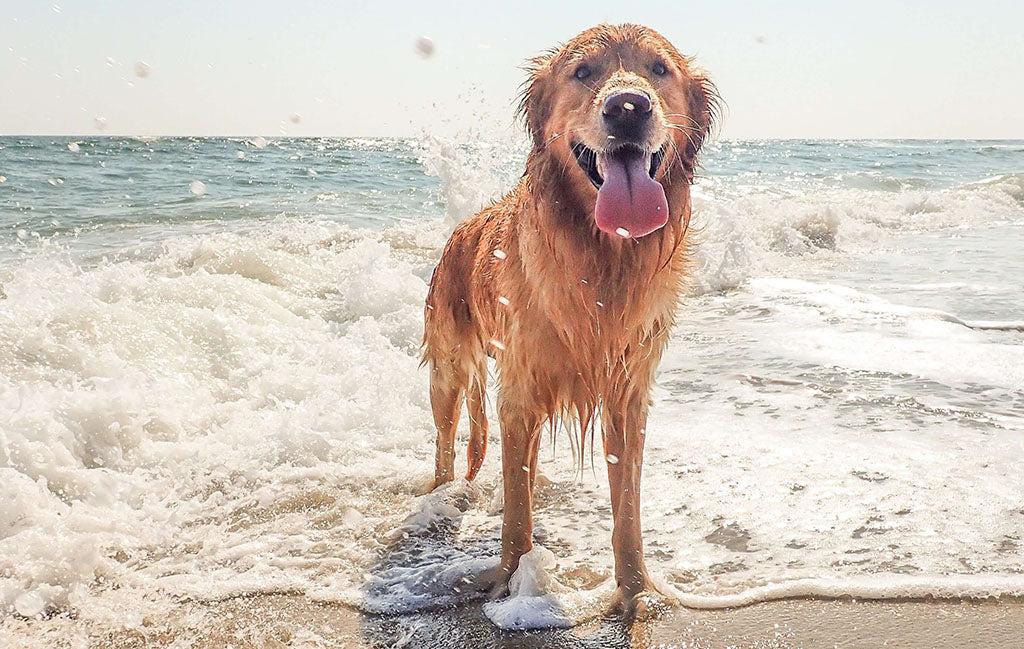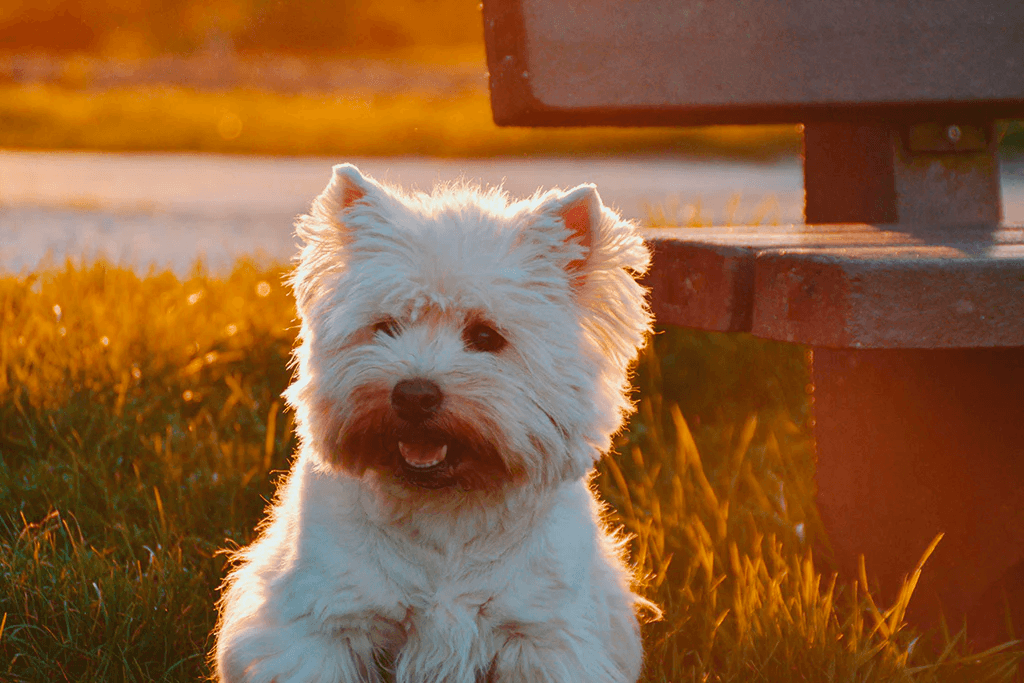“Why is my dog acting weird all of a sudden?” – you’re not the only one to have asked this, pet parent! Sometimes our dogs exhibit odd behaviors and our curiosity gets the better of us. So, why is your dog acting weird?
Why Is My Dog Acting Weird? Here’s 14 Possible Reasons…

Dogs are generally well-behaved and responsive to training, but have you ever noticed your pet acting a little bit odd? Maybe even out of character?
Unfortunately, our companions don’t have the ability to verbally communicate with us humans, and while they might choose to bark at us to try to explain their strange actions, we won’t understand them.
Rest assured, we’ve analyzed some ‘weird’ dog behaviors below, so you can better understand them next time and know when to take action!
Why Is My Dog Acting Weird?
Pressing Their Head
Seeing your dog press their head against the wall is a concerning behavior that requires immediate veterinary attention. This action is not only peculiar and abnormal, but can be a sign of serious underlying issues.
Possible Causes:
- Brain Disease: Conditions such as tumors or encephalitis can cause dogs to press their heads against surfaces due to discomfort or confusion.
- Other Organ Disease: A disease that effects the function of the liver and kidneys can lead to encephalitis, causing the same signs as brain disease.
- Toxic Poisoning: Exposure to toxic substances can lead to neurological symptoms, including head pressing.
How to Help:
If you notice your dog pressing their head against the wall or any other surface, it’s crucial to seek emergency veterinary care immediately. This behavior often indicates a serious health problem that needs prompt diagnosis and treatment. Quick intervention can make a significant difference in your dog’s recovery and overall health.
Biting
Biting is a common behavior in puppies as they explore their environment and learn how to communicate – typically occurring while they’re teething. However, if your puppy bites frequently or without apparent reason, it’s important to address this behavior early to prevent future issues.
Possible Causes:
- Puppy Exploration and Play: Puppies often bite during playtime or training as they learn about their world and social interactions.
- Anxiety or Fear: Mature dogs may bite out of anxiety, fear, or as a reaction to perceived threats.
- Aggression: In some cases, biting can be a sign of aggression.
- Pain or Disease: If your normally gentle dog has begun biting or snapping, they may be reacting to pain or disease in their body.

How to Help:
For puppies, consistent training and positive reinforcement can help curb biting behaviors. Teaching bite inhibition and providing appropriate chew toys are effective strategies.
However, for mature dogs, it’s crucial to identify the underlying causes of biting, such as anxiety or fear, and address them accordingly. Behavioral training, socialization, and, if necessary, consulting with a veterinarian or a professional dog trainer can help manage and reduce biting incidents. Understanding and addressing the root cause is key to preventing further issues and ensuring the safety of both your dog and others.
Going Round In Circles
Dogs often enjoy chasing their tails, and many like to circle before settling down on their beds. However, if your dog frequently circles and seems unable to stop, it may indicate an underlying health issue.
Possible Causes:
- Ear Infections: Infections in the ear can cause discomfort and balance issues, leading to circling behavior.
- Idiopathic Vestibular Syndrome: This condition affects the inner ear and balance, causing disorientation and repetitive circling.
- Brain Tumor (rare): Although rare, a brain tumor can cause neurological symptoms, including circling.
- Mental Health Concerns (rare): While rare, dogs can have mental health conditions such as Obsessive-Compulsive Disorder (OCD) that can appear as circling or other odd behaviors.
How to Help:
If your dog is circling more than usual, appears disoriented, or isn’t actively chasing its tail, it’s important to consult your veterinarian. Early diagnosis and treatment can address the underlying cause and help your dog feel better. Regular check-ups and monitoring for any additional symptoms are crucial in ensuring your dog’s well-being.
Eating Their Own Poop
While it may seem distasteful to us, eating poop can be a common behavior in dogs. Puppies often observe their mothers cleaning them by ingesting feces and may mimic this behavior.
Possible Causes:
- Behavioral Mimicking: Dogs, especially puppies, may imitate the actions they see from their mothers or other dogs.
- Territory Marking: Dogs defecate in certain areas as a way of marking territory. Removing the feces from an area by eating it is also a way of marking (or un-marking) territory.
- Nutritional Deficiency: Consuming feces, known as coprophagia, can sometimes indicate a lack of essential nutrients in a dog’s diet.
How to Help:
If your dog frequently eats their own feces, it’s important to consult with your veterinarian to rule out any underlying nutritional deficiencies or health issues. Your vet may recommend dietary adjustments or products to address any deficiencies. Additionally, maintaining a clean environment by promptly removing feces can discourage this behavior. Proper nutrition and regular health check-ups are crucial for ensuring your dog’s well-being and preventing this and other unwanted behaviors.

There are products that can be added to the food of the dog whose feces are being eaten to prevent this behavior. Unfortunately, this tends to be a temporary solution if not paired with cleaning up and training, so I’m not sure you want to go into it.
Dog Breath Stinks
While it’s normal for dogs not to have minty-fresh breath, a noticeable increase in halitosis can indicate an underlying health issue that needs attention.
Possible Causes:
- Dental Disease: Bad breath may indicate disease of the gums or even the bones of the face.
- Gastrointestinal Issues: Problems in the digestive tract can lead to foul-smelling breath in dogs.
- Liver or Kidney Problems: Organs like the liver and kidneys, when not functioning properly, can cause toxins to build up in the body, resulting in bad breath.
- Diabetes: A sweet or fruity smell in your dog’s breath can be a sign of canine diabetes.
How to Help:
If you notice a significant change in your dog’s breath odor, it’s important to schedule a veterinary check-up. The vet can diagnose the underlying cause, whether it’s related to gastrointestinal issues, liver or kidney problems, or another condition like diabetes. Regular dental check-ups and maintaining good oral hygiene are also essential in preventing dental diseases that can cause bad breath. For more information, consider reading focused blogs on the importance of canine dental health and other related topics.

Digging
Dogs dig for various reasons, such as escaping the heat, tracking animals, or hiding items they find important. This behavior is natural and instinctual for many dogs.
Possible Causes:
- Cooling Down: Dogs may dig to create a cooler spot to lie in, especially in hot weather.
- Hunting Instincts: Some dogs dig to track or hunt small animals, following their natural instincts.
- Comfort Seeking: Digging at blankets or couches indoors can be a way for dogs to find a comfortable spot to lie down.
- Resource Guarding: If a dog wants to protect an item, they may dig a hole to hide it in.
How to Help:
While digging is a normal behavior, it can sometimes become problematic if it leads to damage indoors or disrupts your household. If your dog is digging excessively or in inappropriate places, consider consulting with a reputable and ethical dog trainer. They can help you understand the root cause of the behavior and provide guidance on how to redirect it. Providing appropriate outlets for your dog’s natural instincts, such as designated digging areas or engaging toys, can also help satisfy their needs without causing damage.
Panting
Panting is a common behavior in dogs, especially in hot weather, as it helps them regulate their body temperature. However, panting can also be a sign of other issues.
Possible Causes:
- Heat Regulation: Dogs expel body heat through their mouths, making panting a normal response to warm temperatures.
- Pain or Discomfort: Panting can also be an indicator of pain, stress, or discomfort in dogs.
- Other Diseases: Certain diseases, such as hormone imbalances, can cause excessive panting in dogs.
- Exertion: After physical activity, dogs may pant to cool down and recover.
How to Help:
While panting is often normal, it’s important to monitor the context and frequency. Ensure your dog stays hydrated, especially during hot weather or before physical activities. Provide plenty of fresh water and shade, and avoid excessive exercise during peak heat. If your dog is panting excessively without an obvious reason, or if the panting is accompanied by other symptoms like lethargy or distress, consult your veterinarian. This can help rule out pain, anxiety, or underlying health issues that may require attention.
Scooting
Scooting is when a dog drags their behind on the floor, often seen on rugs or carpets. This behavior indicates discomfort or irritation around the anus.
Possible Causes:
- Anal Irritation: This could be due to the presence of fecal matter, irritation, or even impacted anal glands. This is likely the cause if you notice a distinct smell coming from your dog’s rear end.
- Allergies: Allergies, either environmental or food-related, can cause itching and discomfort leading to scooting.
- Grass or Foreign Matter: Dogs may scoot if they’ve ingested grass or other materials that are difficult to pass.
How to Help:
If you notice your dog scooting, first check to see if there is any obvious cause, such as fecal matter or irritation. Offering a small amount of fiber, like chopped cucumber or cooked pumpkin, can help ease bowel movements and relieve discomfort. If the scooting persists, consider potential allergies, especially if there have been recent changes in diet or increased exposure to grass. Always consult with your veterinarian if the behavior continues, as they can rule out issues such as impacted anal glands, infections, or other medical conditions.
Acting Scared
Dogs may show signs of fear or anxiety, such as trembling, cowering, or hiding, even in situations that seem harmless to humans.
Possible Causes:
- Previous Negative Experiences: Fearful behavior can result from past negative experiences or trauma.
- Sensitivity to New Environments: Dogs may act scared in new or unfamiliar environments, or around new people and animals.
How to Help:
To help a scared dog, create a calm and reassuring environment. Avoid forcing your dog into situations that scare them; instead, allow them to approach new experiences at their own pace. Positive reinforcement, such as treats and praise, can encourage bravery and confidence. If fearfulness is impacting your dog’s quality of life, consider working with a professional dog trainer or veterinary behaviorist to develop a desensitization and counterconditioning plan.
Running All Over the Place (Zoomies)
“Zoomies” refer to the sudden bursts of energy where dogs run around wildly, often in circles.
Possible Causes:
- Excess Energy: Zoomies are typically a way for dogs to release pent-up energy or excitement.
- Stress Relief: Dogs may also use zoomies as a way to relieve stress or excess tension.
How to Help:
Zoomies are generally harmless and a normal behavior for dogs. Ensure your dog gets plenty of physical exercise and mental stimulation to help manage their energy levels. Provide a safe space for zoomies, free from obstacles or hazards. If the behavior becomes excessive or leads to destructive actions, consider increasing your dog’s exercise routine and consult a trainer for additional strategies to manage high energy levels.
Urinating Inside
If your house-trained dog starts urinating inside, it can be a concerning and unexpected behavior, often indicating an underlying issue.
Possible Causes:
- Urinary Tract Infection (UTI): Frequent urination can be a sign of a UTI, causing discomfort and increased urgency.
- Dementia or Cognitive Dysfunction: In older dogs, urinating indoors can be a symptom of cognitive decline or dementia.
- Other Medical Conditions: Conditions such as diabetes, kidney disease, or hormonal imbalances can also lead to changes in urination habits.
How to Help:
Monitor your dog’s urination patterns and take note of any changes, such as increased frequency or discomfort. Schedule a veterinary checkup to diagnose the underlying cause, especially if your dog has never exhibited this behavior before. Prompt treatment can address infections or other medical issues, helping to restore normal urinary habits.
Yawning
Unlike humans, dogs often yawn as a response to stress or discomfort rather than tiredness.
Possible Causes:
- Fear or Anxiety: Yawning can be a sign of fear, stress, or discomfort, particularly in unfamiliar situations or around strangers.
- Communication: Dogs may yawn to communicate their feelings, signaling that they are uncomfortable or uncertain.
How to Help:
If your dog yawns frequently, especially in the presence of strangers or in new environments, it may be experiencing anxiety. To help your dog feel more comfortable, introduce them to new people and situations gradually. Avoid rushing interactions and provide a calm, reassuring environment. If your dog’s anxiety seems severe or persistent, consider consulting a veterinarian or professional dog trainer for additional support and strategies to help your dog feel more at ease.
Tucking Their Tail
Tucking the tail between the legs is a common sign of fear, submission, or discomfort in dogs.
Possible Causes:
- Fear or Anxiety: This behavior often occurs in response to frightening or stressful situations, such as loud noises or unfamiliar people.
- Submission: Dogs may tuck their tails as a submissive gesture, indicating that they are not a threat.
How to Help:
Observe the context in which your dog tucks their tail to identify the trigger. Provide a safe and supportive environment, and avoid situations that cause fear or discomfort whenever possible. Gradually introduce your dog to new experiences with positive reinforcement to build their confidence. If your dog’s tail-tucking behavior is frequent or severe, seek advice from a veterinarian or behaviorist.
Being Clingy
Dogs can become unusually clingy, seeking constant attention and following their owners around the house.
Possible Causes:
- Separation Anxiety: Clinginess can be a sign of separation anxiety, where dogs become overly attached and distressed when apart from their owners.
- Insecurity or Fear: Dogs may seek comfort and reassurance from their owners during times of insecurity or fear, such as during thunderstorms or fireworks.
How to Help:
If your dog is becoming excessively clingy, it’s important to address the underlying cause. Gradually build your dog’s confidence by practicing short periods of separation and rewarding calm behavior. Provide a safe and comfortable space for your dog to retreat to when they’re feeling anxious. If the behavior persists or worsens, consult with a veterinarian or a veterinary behaviorist for guidance and support.

Possible Causes of Weird Behavior
Dogs can exhibit unusual behaviors for a variety of reasons, ranging from physical health issues to emotional factors. Understanding the underlying causes of these behaviors is crucial for ensuring your dog’s well-being and addressing any potential problems. Here are some common causes of weird dog behavior:
Health Issues
Physical health problems can significantly impact a dog’s behavior. Conditions such as infections, gastrointestinal issues, or dental pain can cause discomfort and lead to unusual actions like urinary accidents, scooting, or bad breath. It’s essential to monitor your dog’s health closely and consult a veterinarian if you notice any sudden or unexplained behavioral changes.
Neurological Issues
Neurological disorders, including epilepsy, brain tumors, or idiopathic vestibular syndrome, can manifest as strange behaviors in dogs. Symptoms may include circling, head pressing, or seizures. If you suspect a neurological issue, seek veterinary care immediately, as early diagnosis and treatment are vital.
Stress/Anxiety
Stress and anxiety are common causes of weird dog behavior. Dogs may display signs of anxiety through excessive barking, zoomies, yawning, or even destructive behavior. Factors such as changes in routine, unfamiliar environments, or separation from their owners can trigger these reactions. Providing a stable and reassuring environment can help alleviate anxiety in dogs.
Boredom
Boredom can lead to behaviors like excessive digging, chewing, or barking. Dogs need mental and physical stimulation to stay happy and healthy. Providing plenty of toys, regular exercise, and engaging activities can help prevent boredom-related behaviors.
Fear
Fear can cause dogs to act out in ways that seem strange or unusual. This might include cowering, trembling, hiding, or even aggression. Common triggers include loud noises, unfamiliar people or animals, and previous traumatic experiences. Understanding and addressing the source of your dog’s fear can help reduce these behaviors.
Aging
As dogs age and become seniors, they may experience cognitive decline, leading to behaviors like confusion, increased vocalization, or changes in sleep patterns. Conditions such as canine cognitive dysfunction (similar to Alzheimer’s in humans) can cause disorientation and altered behavior. Regular vet check-ups can help manage aging-related issues and improve your dog’s quality of life.
Physical or Emotional Trauma
Dogs that have experienced physical or emotional trauma may exhibit behaviors such as aggression, withdrawal, or hyper-vigilance. These reactions can be a response to past abuse, accidents, or other traumatic events. Patience, gentle handling, and professional training can help dogs recover from trauma and reduce these behaviors.
Understanding the root causes of your dog’s unusual behavior is essential for providing the appropriate care and support they need. If you’re unsure about the cause or how to address it, consult with your veterinarian or a professional dog trainer for guidance.
What to Do if Your Dog is Acting Strange
If you notice your dog exhibiting unusual or strange behavior, it’s important to take proactive steps to address the issue and ensure their well-being. Here are some tips for pet parents on what to do:
Document the Onset and Symptoms
Start by documenting the onset of the strange behavior and any associated symptoms. Note when the behavior began, how frequently it occurs, and any specific triggers or patterns you’ve observed. This information can be invaluable when discussing the issue with your veterinarian or a professional behaviorist.
Take Videos of the Behavior
Whenever possible, capture videos of your dog’s behavior. Videos can provide a clear and detailed record of the actions in question, making it easier for your vet or a behaviorist to assess the situation. It’s often challenging to describe certain behaviors accurately, so visual evidence can be very helpful.
Ensure a Safe and Secure Environment
While you work on identifying the cause of the behavior, ensure that your dog’s environment is safe and secure. Remove any potential hazards that could harm your dog if they continue acting strangely. Providing a calm and quiet space can also help reduce stress and anxiety, which may be contributing to the behavior.
Consult with Your Veterinarian
Discuss all behavior changes with your veterinarian to rule out any health-related causes. Many strange behaviors can be linked to underlying medical conditions, such as infections, pain, or neurological issues. Your vet can conduct a thorough examination and recommend appropriate tests or treatments.
Work with a Certified Veterinary Behaviorist
If the behavior is not linked to a medical issue, consider working with a certified veterinary behaviorist. These professionals can help identify the root causes of the behavior and develop a tailored training plan to address it. Whether the issue is anxiety, fear, or aggression, a behaviorist can provide valuable guidance and support in modifying your dog’s behavior.
Be Patient and Consistent
Behavioral changes can take time to address, so be patient and consistent with any recommended training or treatment plans. Reinforce positive behaviors and avoid punishing your dog, as this can exacerbate the problem and create additional stress.
By taking these steps, you can better understand and address your dog’s strange behavior, ensuring their health and happiness. Remember, early intervention is key to resolving behavioral issues and maintaining a positive bond with your furry friend.
Dog Acting Strange Final Thoughts
A dog’s way of being doesn’t change without a reason, so take note of any behavioral changes.
Underlying issues may be manifesting through these actions, so it’s better to be safe than sorry. Book an appointment with your vet as soon as possible if you notice any major weird changes in your dog’s behavior.
 B
B




